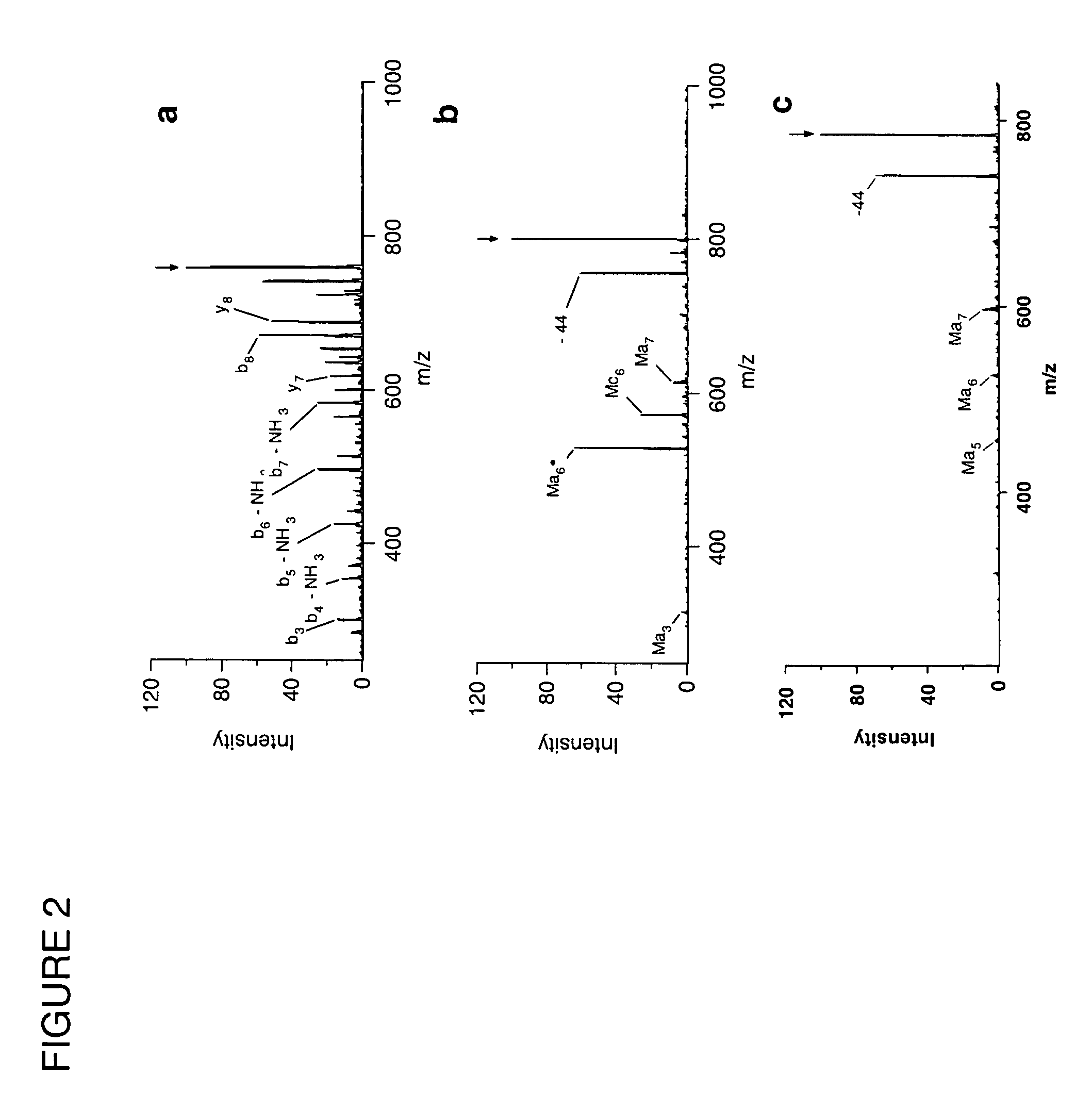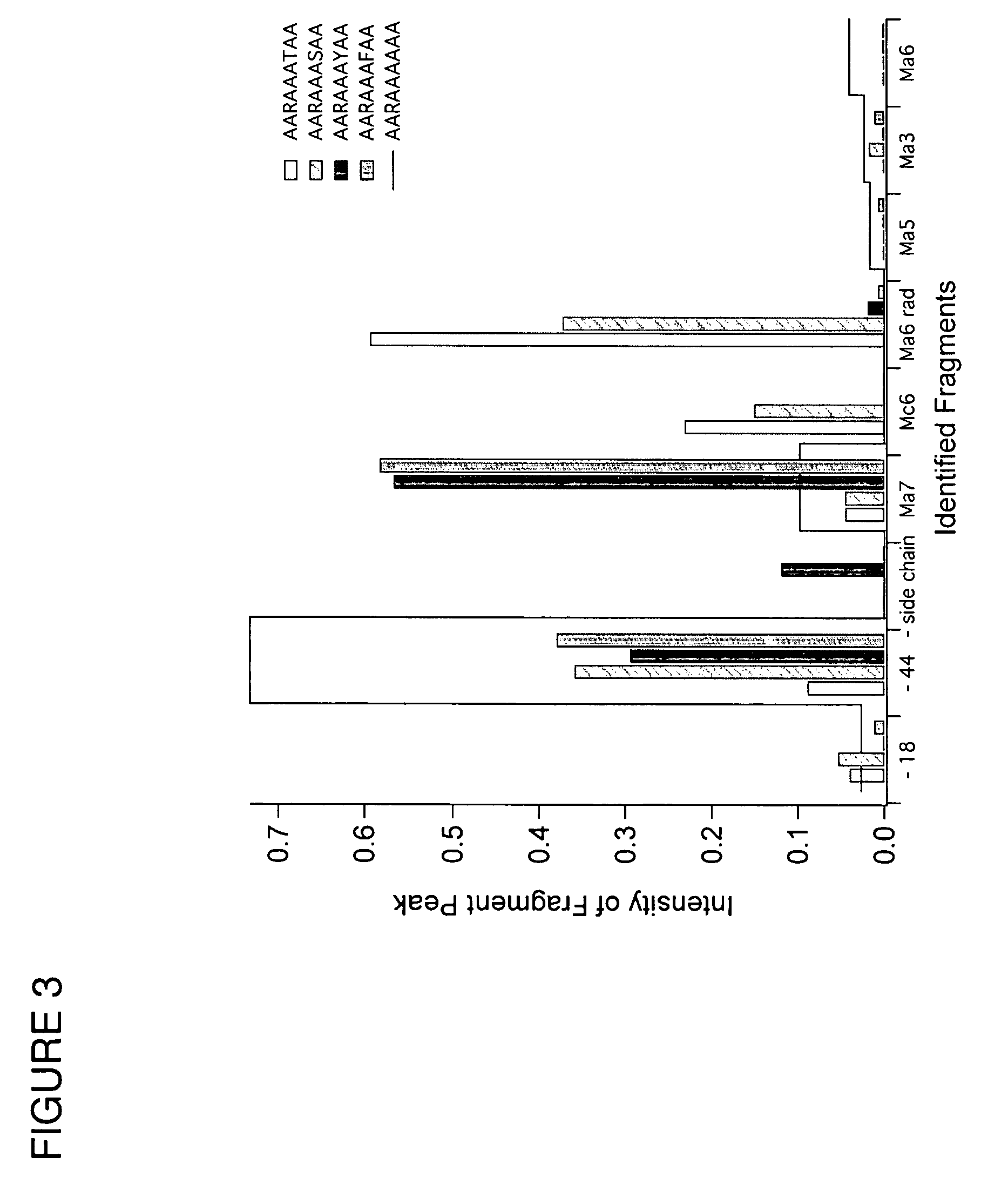System and method of free radical initiated protein sequencing
a free radical and protein technology, applied in the field of protein sequencing, can solve the problems of significant reduction of the throughput of proteomic analysis, limited selectivity of this technique, and easy synthesis of molecule fragments, and not yielding sequence-specific information
- Summary
- Abstract
- Description
- Claims
- Application Information
AI Technical Summary
Problems solved by technology
Method used
Image
Examples
example 1
Covalently Bound Radicals
[0070] In one exemplary embodiment, the water-soluble free radical initiator Vazo 68, shown in Scheme 1, is conjugated to the N-terminus of a peptide. The conjugate is electrosprayed into an ion trap mass spectrometer, where CID results in free radical formation at the azo moiety.
[0071] In the current example, Vazo 68 was procured from DuPont (www.dupont.com). To synthesize conjugated peptides, Vazo 68 and N,N-dicyclohexylcarbodiimide (DCC) were dissolved in N,N-dimethylformamide (DMF) at concentrations of approximately 40 mM. This solution was added to an equivalent volume of 2-5 mg / mL aqueous solution of peptide and the reaction mixture was protected from light. All peptides were obtained from American Peptide Company (Sunnyvale, Calif.). The reaction was allowed to progress for one hour. This solution was then diluted by 105 in methanol and used in electrospray experiments. Vazo 68 was in turn transformed to the dichloride species and added to 18-crown-...
example 2
Noncovalently Bound Radicals
[0080] The crown ether 18-crown-6 (18c6) complexes readily with ammonium ions in the gas phase. (See, Maleknia, S.; Brodbelt, J. J. Am. Chem. Soc. 1993, 115, 2837, the disclosure of which is incorporated herein by reference.) This molecule has been previously used for molecular recognition of lysine in small peptides and proteins. The compound in Scheme 8 was synthesized to combine the molecular recognition properties of 18c6 with the radical initiator Vazo 68. The compound should preferentially bind to lysines, and the radical generated from this species, Scheme 13, could then cleave a peptide at sites adjacent to a lysine residue.
[0081]FIG. 11 shows the results of an experiment using 5.1 and the peptide prodynorphin (PDN), with the sequence YGGFLRRQFKVVTRSQEDPNAYYEELFDV. This peptide has three arginine (R) residues and one lysine (K) residue. The full mass spectrum shown in FIG. 11a shows formation of adduct peaks. When the +3 adduct is dissociated, ...
example 3
PTMs
[0083] In many proteomics studies, the identification of post-translational modifications (PTMs) to proteins is critical to identifying regulatory pathways. (See, e.g., Mann, M.; Ong, S. E.; Gronborg, M.; Steen, H.; Jensen, O. N.; Pandey, A. “Analysis of protein phosphorylation using mass spectrometry: deciphering the phosphoproteome,”Trends in Biotechnology. 2002, 20, 261-268, the disclosure of which is incorporated herein by reference.) In particular, phosphorylation plays a major role in transmembrane signal transduction, and approximately one-third of eukaryotic proteins are phosphorylated at any given time. Hunter, T. Signaling—2000 and beyond. Cell. 2000, 100, 113-127; Zolnierowicz, S.; Bollen, M. “Protein phosphorylation and protein phosphatases,”The EMBO Journal. 2000, 19, 483-488, the disclosures of which are incorporated herein by reference.) Abnormal phosphorylation is often a cause or result of a disease state. (See, e.g., Cohen, P. “Protein kinases—the major drug t...
PUM
 Login to View More
Login to View More Abstract
Description
Claims
Application Information
 Login to View More
Login to View More - R&D
- Intellectual Property
- Life Sciences
- Materials
- Tech Scout
- Unparalleled Data Quality
- Higher Quality Content
- 60% Fewer Hallucinations
Browse by: Latest US Patents, China's latest patents, Technical Efficacy Thesaurus, Application Domain, Technology Topic, Popular Technical Reports.
© 2025 PatSnap. All rights reserved.Legal|Privacy policy|Modern Slavery Act Transparency Statement|Sitemap|About US| Contact US: help@patsnap.com



